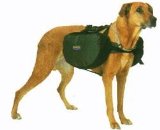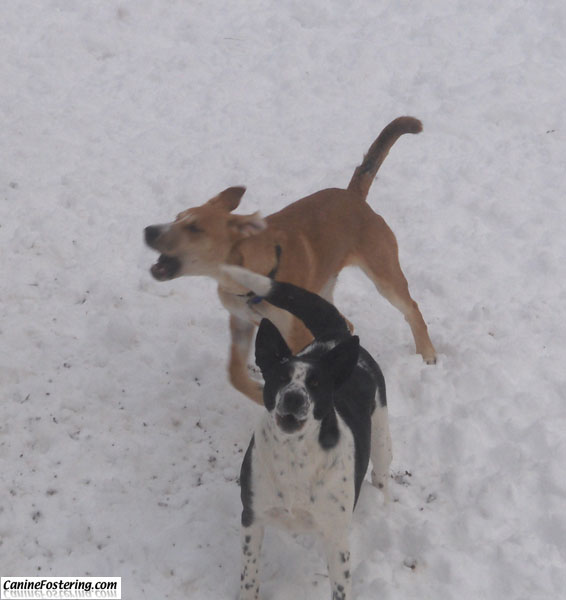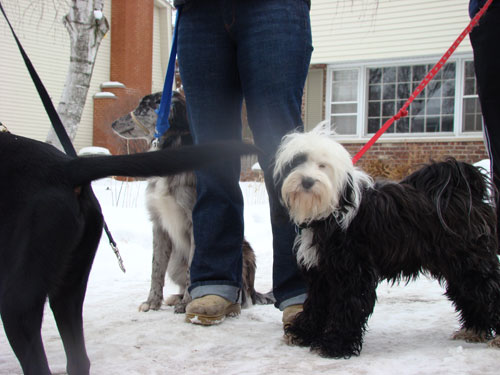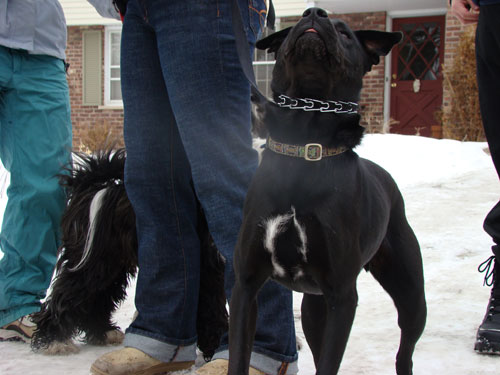Letter from a frustrated dog owner
Here’s an exchange with a person who I’ve been working with recently to get their dog ready to take the American Kennel Club‘s Canine Good Citizen (CGC) test.
The question:
Kristin,
I’m really frustrated with where we are right now with S’s walking. As long as there are no distractions, he does fairly well. It’s something we could continue to work with. But if there are distractions, it all goes out the window. Last night he saw a squirrel within the first 100 yards and from then on he was pulling at the leash the whole time looking for the next squirrel or rabbit. I had been hoping to have a pleasant walk so I didn’t have any treats with me. But it really wouldn’t have mattered. You can get his attention with a “watch”, depending on how far away the distraction is, but as soon as you reward him for it, he’s back to the distraction.I’m really torn. I’d like to not have to be in training mode every time we go for a walk. Plus, to really do it right, I would need a whole bag of treats and would have to eliminate a meal. But if I don’t work with him, then I feel I’m reinforcing negative actions on his part. And my arm gets tired.
Plus I have no idea how you trained your dogs not to pee or poop on walks. It takes him less than a stride to get all four feet planted and he’s almost immovable then. Any ideas?
T-
And my response:
Dear T-
Not being next to you on the walk makes it hard for me to really get what’s going on. Maybe one of these nice late summer days we could do just that…? But, what you have to do is to keep up with the walking. I agree, treats aren’t really the answer. It is sort of about respect in my opinion…he believes his “work” (hunting critters – his job that he’s assigned himself in lieu of anything else to do) is more important than anything you have to tell him. So, somehow, we’ve got to get across that we have a different job in mind for him, a better one. But until he gets this, really understands this on his doggy level, he just doesn’t see the point in not doing it.
 So, sometimes a harsher correction tool can help – a prong/pinch collar helps communicate in no uncertain terms that his behavior isn’t appreciated. The correction makes sense to him and is aversive enough (without being cruel) to get through to him that you want him to stop. Other options include giving him another job while on walks. That’s where a good back pack comes in handy. I recommend dog back packs from RuffWear. They make packs that I’ve seen and used and are acceptable. Fill the pack with up to 20% of S’s body weight and then go for the walk. It is amazing how this can change a dog. Plus, it’s hard to pee with a pack on.
So, sometimes a harsher correction tool can help – a prong/pinch collar helps communicate in no uncertain terms that his behavior isn’t appreciated. The correction makes sense to him and is aversive enough (without being cruel) to get through to him that you want him to stop. Other options include giving him another job while on walks. That’s where a good back pack comes in handy. I recommend dog back packs from RuffWear. They make packs that I’ve seen and used and are acceptable. Fill the pack with up to 20% of S’s body weight and then go for the walk. It is amazing how this can change a dog. Plus, it’s hard to pee with a pack on.
So, try those things. However, your comment about not wanting to be in training mode with each walk is also a clue that you are losing your patience. I hope you come to accept that you kind of do need to always be in training mode when out with your dog. The training gets easier with time, but you can never just check out. It’s sort of like parenting – you’re always on, no matter how old they get. The older they get, the easier and less intensive the work is, but you still are the dad, always. So, try to find a place of acceptance with that fact. So, try to find a place of acceptance with that fact. This doesn’t mean that you have to tolerate a sore arm and a disrespectful dog, but you do have to continue training him his whole life.
Let me know if this helps.
-Kristin
What to do about dog barking
 A question comes in on problem barking:
A question comes in on problem barking:
Q: Any suggestion as to how we can work with our dog when she is sitting in our yard, and barking at others who walk pass our house?
A: Barking is self-reinforcing. That means you don’t have to do anything for the behavior to become a habit. That is why bark collars (the citronella and static shock kind) work – they give a negative correction when the bark happens, breaking the habit. But, before deciding on one of those, I like to try to train the dog to “quiet” on command. To do so, you have find a way to encourage them to bark, and name it a command name (like “speak” or “defend”). When you say that command word, knock on the wall or do what it takes to get the dog to bark. Then, after they bark 3 or 4 times, say, “QUIET” and “Watch!” As they turn toward you, give a treat. So you begin to associate “quiet” with a treat. The other thing you can try is to tell her to “leave it” as she is barking and call her to “come“. Once she is next to you, treat her and bring her inside.
Really, most dogs will bark and that is ok – it just becomes a problem when we have no off switch or if the barking becomes excessive – as can be the case for a dog who isn’t getting enough exercise or stimulation. You have to assess the situation and see what applies to you.
What to do when dogs fight
I got a question recently about fighting breaking out in a pack of three male dogs who up to this point were getting on fairly well. Here is my response:
 Given that one of the dogs is 10 months old, the increased fighting may be due to increasing testosterone levels in the youngest dog. (The older two are neutered, the youngest was just neutered) Even after he is neutered, these levels will remain high for some time. High testosterone levels not only cause a dog to be more prone to assert himself, they also cause other dogs to assert themselves more frequently toward him.
Given that one of the dogs is 10 months old, the increased fighting may be due to increasing testosterone levels in the youngest dog. (The older two are neutered, the youngest was just neutered) Even after he is neutered, these levels will remain high for some time. High testosterone levels not only cause a dog to be more prone to assert himself, they also cause other dogs to assert themselves more frequently toward him.
Don’t be so quick to let the only dog who “isn’t starting the fights” off the hook. Unless you are watching very closely, you may be missing the ways he is starting them. Some dogs have an uncanny way of winding up other dogs with just a look. He may also be using the placement of his body in a way that signals a direct challenge. Just because one dog is quiet doesn’t mean he isn’t causing trouble!
 All the dogs in the pack are doing what any group of dogs do…working out their status relative to one another. This will happen and it isn’t necessarily a problem as long as you are clear to the dogs that the humans are ultimately in charge. I wouldn’t suggest doing things to challenge the status that is already in place, such as feeding the highest ranking dog last – you run the risk of them fighting even harder when you aren’t around. But neither would I support the status, like allowing a higher ranking dog to take the bone or bed of a lower status dog who is using it. I have a rule in my house: “If your nose is in it or your butt is on it it is yours unless I want it and then it is MINE.” No other dogs have the power to displace (more…)
All the dogs in the pack are doing what any group of dogs do…working out their status relative to one another. This will happen and it isn’t necessarily a problem as long as you are clear to the dogs that the humans are ultimately in charge. I wouldn’t suggest doing things to challenge the status that is already in place, such as feeding the highest ranking dog last – you run the risk of them fighting even harder when you aren’t around. But neither would I support the status, like allowing a higher ranking dog to take the bone or bed of a lower status dog who is using it. I have a rule in my house: “If your nose is in it or your butt is on it it is yours unless I want it and then it is MINE.” No other dogs have the power to displace (more…)
The WATCH and LEAVE IT commands
“Watch” means keep your eyes on my eyes. We teach this by showing the dog a treat while we place our face in their line of vision. As we give the treat we say “watch.” A dog will usually get this pretty fast. Then you can move the treat away from your face while tapping your nose with your other hand as you say “watch.” The movement of the treat-free hand draws the dog’s attention back to your eyes from the treat which they invariable track. As the dog’s eyes are on you, pop the treat in the dog’s mouth. The better your timing on this one the faster the dog learns it. Make sure you are only giving the treat while the dog’s eyes are on your eyes. Many dogs will avoid eye contact out of submission or respect and that is fine. Don’t demand direct eye contact from a submissive or young dog. Just make sure the eyes are looking toward your nose, forehead, or chin. As your dog builds confidence with this exercise they will look into your eyes.
“Leave it” means take your attention off of that thing (food, dog, person, goose poop, etc, and put it on me). To practice leave it, put a treat in front of your dog while he is on leash. Make sure that he cannot under any circumstance get to the treat! As you place the treat say “LEAVE IT” in a firm commanding tone and hold on tight to the leash. He will likely strain to get to the treat. Refrain from repeating the word leave it over and over again. Eventually, the dog will give up and often they will look at you…praise this immediately by giving them a treat from your hand (not the one on the floor) and saying “good dog” or something like that. The dog will then usually try to go for the treat on the floor and when they do you say “LEAVE IT” again in a firm voice and repeat. The dog will catch on fast. That is the first part of the exercise.
[flashvideo file=images/watchleaveit.flv /]




